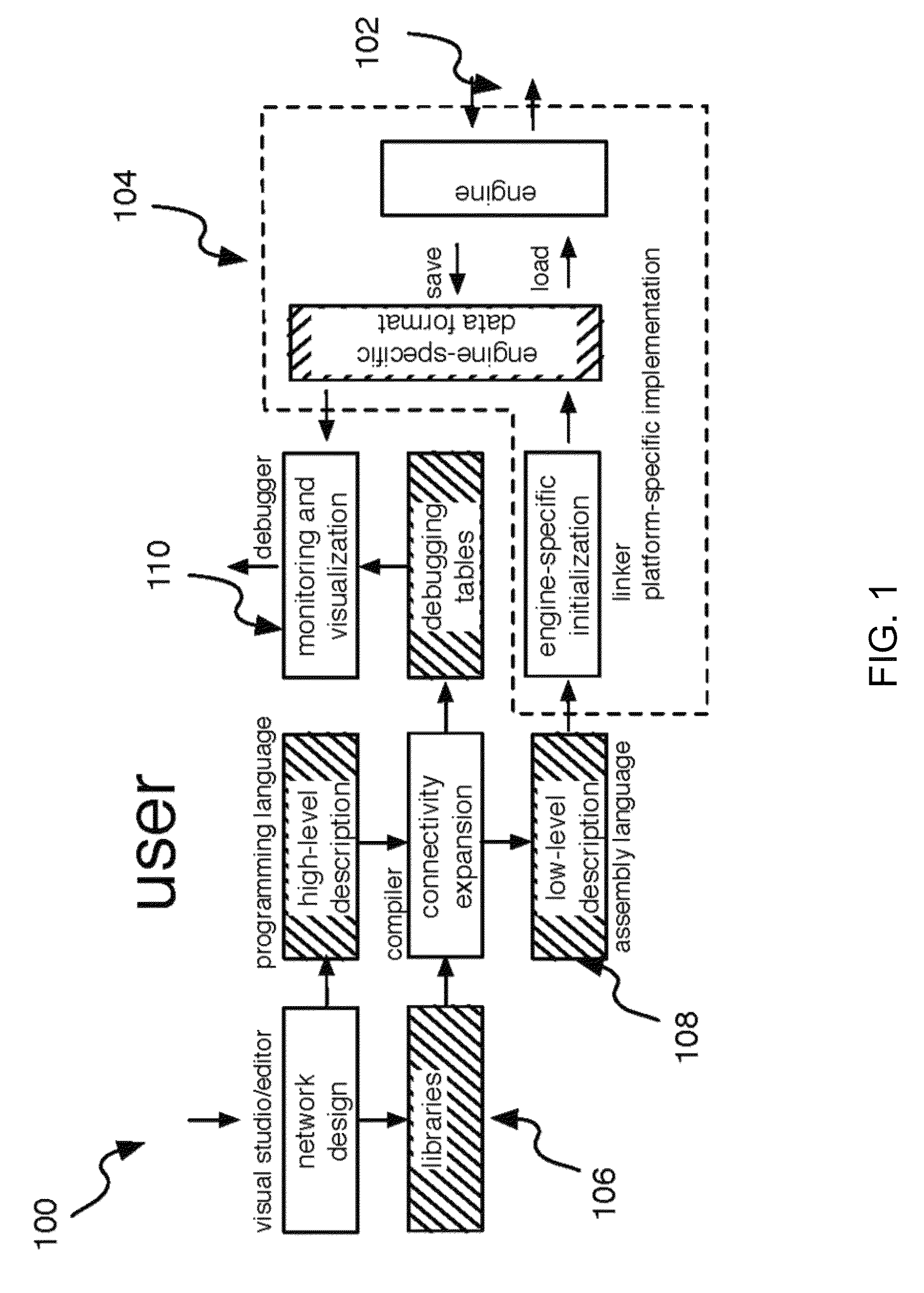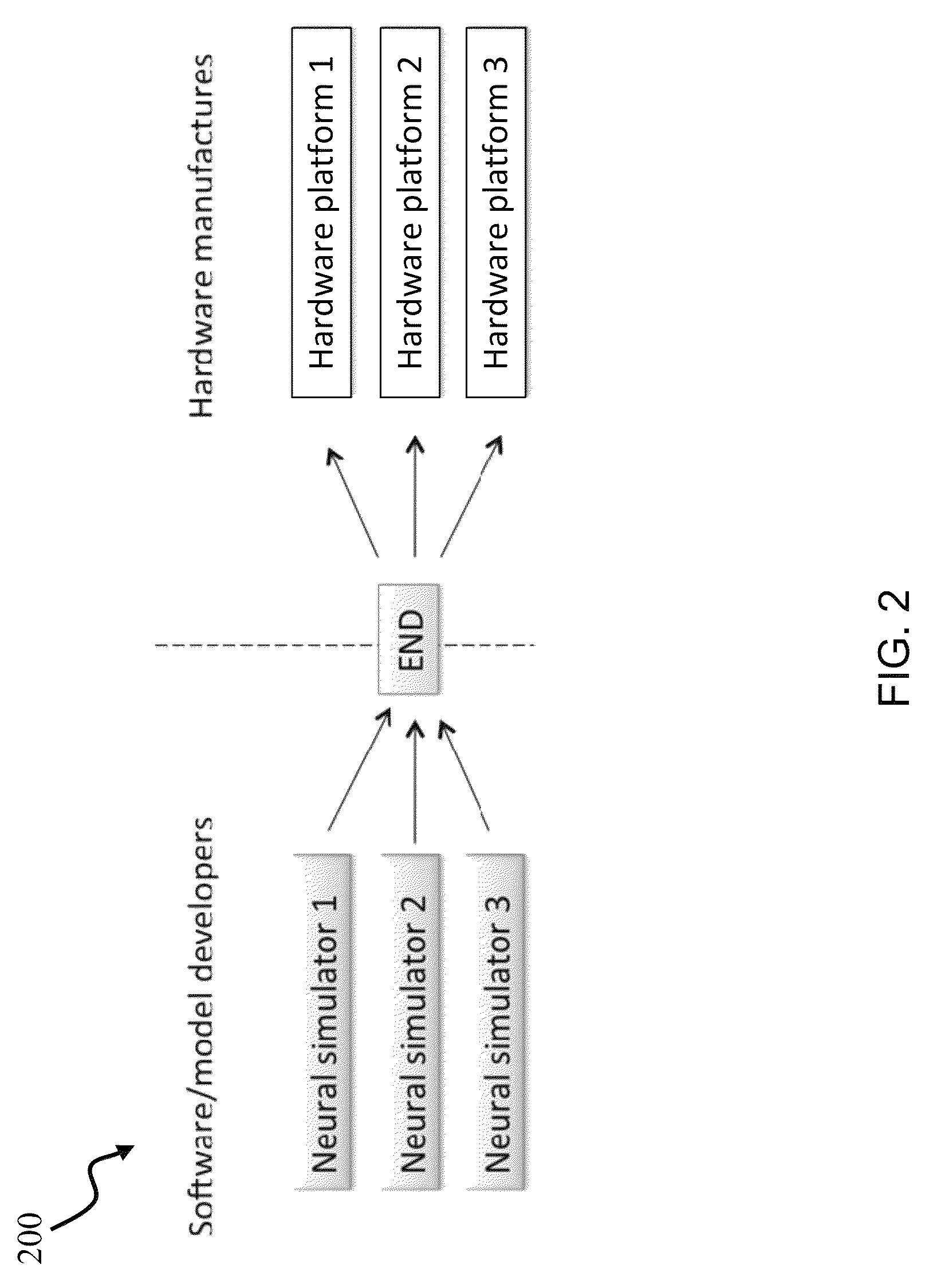Elementary network description for efficient memory management in neuromorphic systems
a neuromorphic system and memory management technology, applied in computing models, biological models, instruments, etc., can solve the problems of cumbersome tools used to design optimized software or hardware engines to efficiently simulate such models, and languages are not appropriate for parallel simulation of neuronal systems
- Summary
- Abstract
- Description
- Claims
- Application Information
AI Technical Summary
Benefits of technology
Problems solved by technology
Method used
Image
Examples
example 1
spnet
[0143]The spnet typically comprises N=Ne+Ni=1000 neurons, where Ne=800 excitatory neurons and Ni=200 inhibitory neurons. Each neuron typically comprises M=100 synapses per neuron. All excitatory synapses are plastic (STDP), with a random delay ranging between 1 ms and D=20 ms. The inhibitory→excitatory synapses are non-plastic with a delay of D=1 ms. There are no inh→inh synapses. The low-level END description of the model is expressed as follows. The first Ne units are populated by Ne excitatory units:
[0144]
unit_id = 1:800
Next, Ni inhibitory units are records of the class are populated as:
[0145]
unit_id = 801:1000
The spnet class is then declared as shown in the Listing 1 below:
[0146]
Listing 1.unit_class_id=‘QIF2’update_rule = ‘v+=0.5*((0.04*v+5).*v+140−u+I);v+=0.5*((0.04*v+5).*v+140−u+I);’event_condition = ‘v>30’after_event_rule = ‘v=−65;’initialization = ‘float v=−65; float u=0.2*v; float I=0’unit_class_id=‘exc’update_rule = ‘u+=0.02.*(0.2*v−u);’after_event_rule = ‘u+=8; last_...
example 2
Global Variables
[0200]
name = ‘DA_update’code = ‘DA = exc[3].v + inh[1].u’init = ‘analog DA = 0’update_rule = ‘DA_update’
Example 3
spnet
[0201]The standard spnet network has N=1000 neurons; among them are Ne=800 excitatory neurons and Ni=200 inhibitory neurons, with M=100 synapses per neuron. All excitatory synapses are plastic (STDP), with random delay between 1 and D=20 ms. The inhibitory→excitatory synapses are non-plastic with delay D=1 ms. There are no inh→inh synapses. The low-level description of the model is below.
[0202]
name=‘QIF2’ / / only the v equation definedcode = ‘v+=(0.04*v+5).*v+140+I; I=4*rand( ) / MAX_RAND’name=‘spike’code = ‘v>30’name = ‘exc’update_rule = ‘u+=0.02*(0.2*v−u); I−=u;’update_rule = ‘QIF2’event_condition = ‘spike’after_event_rule = ‘v=−65; u+=8; last_spike=now’init = ‘analog v=−70, u=−14, I=0; int last_spike=−1000’name=‘inh’ / / inhibitory neuronupdate_rule = ‘u+=0.1.*(0.2*v−u); I−=u;’update_rule = ‘QIF2’event_condition = ‘spike’after_event_rule = ‘v=−65; u+=...
example 3
spnet with No Delays
[0257]A network of randomly connected 800 excitatory and 200 inhibitory neurons (100 of exc→all and inh→exc connections) can be defined with excitatory synapses subject to STDP and no conduction delays (for conduction delays, see next example).
[0258]
Listing 6QIF = rulecode = ‘v+=0.5f*((0.04f*v+5.0f)*v+140.0f−u+I);v+=0.5f*((0.04f*v+5.0f)*v+140.0f−u+I); I=0.0f;’exc = elementcode = ‘u+=0.02f*(0.2f*v−u);’code = QIFrank = 0init = ‘float v=−65.0f; float u=−13.0f; float I=0.0f; intlast_spike=−1000’1:800 = excinh = elementcode = ‘u+=0.01f*(0.2f*v−u);’code = QIFrank = 0init = ‘float v=−65.0f; float u=−13.0f; float I=0.0f; intlast_spike=−1000;’1:200 = inhspike = rulecode = ‘v>30’after_spike_reset_exc = eventtrigger_condition = spiketrigger_rank = 0.1target_rule = ‘u+=8; last_spike=now’target_rank = 0.2after_spike_reset_exctrigger = exc.1:800target = exc.1:800after_spike_reset_inh = eventtrigger_condition = spiketrigger_rank = 0.1target_rule = ‘u+=2; last_spike=now’target_r...
PUM
 Login to View More
Login to View More Abstract
Description
Claims
Application Information
 Login to View More
Login to View More - R&D
- Intellectual Property
- Life Sciences
- Materials
- Tech Scout
- Unparalleled Data Quality
- Higher Quality Content
- 60% Fewer Hallucinations
Browse by: Latest US Patents, China's latest patents, Technical Efficacy Thesaurus, Application Domain, Technology Topic, Popular Technical Reports.
© 2025 PatSnap. All rights reserved.Legal|Privacy policy|Modern Slavery Act Transparency Statement|Sitemap|About US| Contact US: help@patsnap.com



